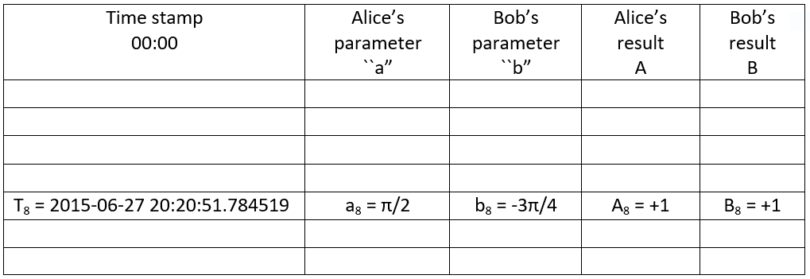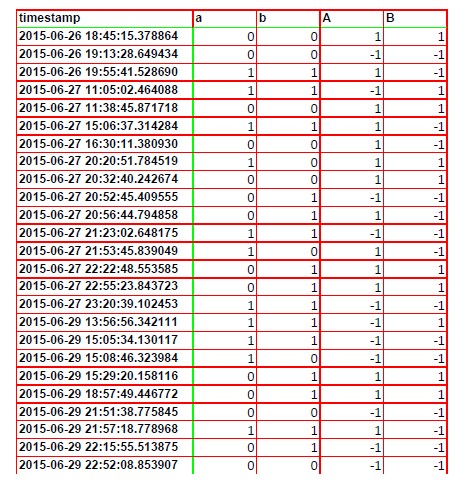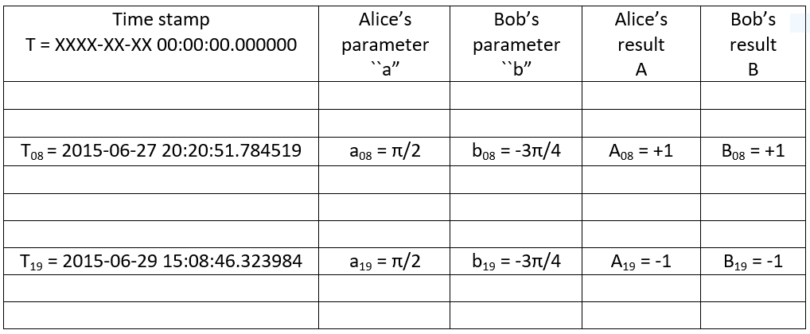FrediFizzx wrote:The experimenters are simply observing what Nature does. Here is a link to download the raw dataset.
https://data.4tu.nl/repository/uuid:6e1 ... 60bf3c0a31Download the zip file at the bottom of the page. You can decipher the raw dataset on your own by reading all the instructions in the paper, etc. There is nothing funny going on with table above. It is simply what the experimenters observed. I will run my own CHSH analysis on it to see what the result is.
Ok, thanks. Let us concentrate on just one run of the experiment. Let us say the experimenters have observed, as claimed, the following results, which are borrowed from the above table:

Now I am not really concerned about whether or not the post-processing of the data is kosher and whether or not the experiment verifies the strong correlations predicted by quantum mechanics. I just want to concentrate on the above single run of the experiment and the corresponding results tabulated above. And then I want to make the following observations:
(1) Quantum mechanics does not predict the above definite results, namely A = +1 and B = +1, for the listed parameters "a" and "b",
even in principle. That is the very nature of that theory. All it can predict for the listed parameters "a" and "b" is that the result A will either be equal to +1 or be equal to -1, and the result B will either be equal to +1 or be equal to -1, with the probability of both A and B turning out to be equal to +1 being 42.7%. That is the best quantum mechanics can do. It can only make probabilistic statements.
(2) Now, as you say, the "experimenters are simply observing what Nature does." So let us accept that they have indeed observed A = +1 and B = +1 for the listed parameters. How is that possible when quantum mechanics cannot predict those results even in principle? The experimenters had only 42.7% chance of observing those results and they seem to have lucked out.
(3) Can a local-realistic theory do better? Not really. And more importantly, it should not be demanded to do better. The goal of local realism is not to refute quantum mechanics or go beyond quantum mechanics in any sense, but simply to reproduce what quantum mechanics predicts, with the same probabilities, but with a more coherent philosophical grounding. In particular, a local-realistic theory can be required to provide epistemic probabilities for the possible results rather than intrinsic probabilities offered by quantum mechanics, but in no sense should it be required to go beyond quantum mechanics. In other words, a local-realistic theory should predict exactly the same probability for the results A = +1 and B = +1, namely the probability 42.7%, but without compromising locality or reality.
(4) So what am I getting at? What I am saying is that the usual demand by Bell-believers that a local-realistic theory must make a definite prediction, such as A(a, h) = +1, given the listed parameter "a" and a hidden variable h, is completely scandalous. That would be surreptitiously requiring a local-realistic theory to go
beyond quantum mechanics and predict something that quantum mechanics is unable to predict. That is a grossly excessive demand. Nothing in Einstein's conception of local realism requires a local-realistic theory to accomplish that.
(5) Now some may argue that given the complete information encapsulated in the hidden variable h, and given an experimental parameter "a", the result A(a, h) = +1 must be predictable by a local-realistic theory, with certainty. But that is nonsense. Just like the prediction of weather or a result of a coin toss, in-principle-complete information does not necessarily mean that we should be able to predict the result A(a, h) = +1 with certainty in practice. It only means that, unlike in quantum mechanics, the information is actually there but we are unable to extract it to make a definite prediction. For if we could extract that information, then our predictions would go beyond those of quantum mechanics, thereby revolutionizing physics.
***





